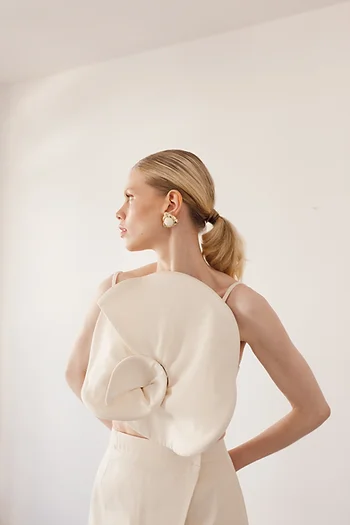Mayara Junges has a degree in Fashion Design and a postgraduate degree in modeling and moulage, and draws attention for her career as recent as it is relevant.
Raised in the interior of Paraná, Brazil, with a seamstress grandmother, the designer found digital means to explore and nurture her creativity. During our chat, we shared ideas and inspirations, seeking to understand a little more about the dedication involved in creating her original pieces, now available in stores such as Shop2gether and Pinga Store.
What was the process of creating your own brand like? Was there a pivotal moment?
I had worked in fashion for years, but had never thought about having my own brand. Everything changed when I created "Top Flor" as part of my postgraduate project. I posted some photos on my personal Instagram and, to my surprise, the piece took off — and is one of the best sellers to date. It takes me almost a day to finish this top, including cutting it out by hand, modeling it on the mannequin, inserting fins and interfacing. The entire process is very manual, so it really carries the essence of the brand.
My previous experience as a salesperson was also crucial in this journey. The decision to open the brand in my living room was driven by this practical background, of combining what the customer is looking for with what is missing in the market.
Slow design is a central approach to your brand. Can you share with us why you chose this path and how it impacts the business?
I chose to launch new pieces every 3 or 4 months, following the idea of drops and keeping production on demand. With a small stock available for customers interested in getting to know the studio, I avoid the rush of creating new products just for the sake of creating them, and am able to prioritize quality and attention to detail. The satisfaction is creating handcrafted pieces that I would love to wear and see on the streets.
My focus is to create clothes with volume and information, versatile enough to adapt from everyday situations to parties or special events. The choice of neutral tones is an extension of this thought, that pieces should stand the test of time and be used on different occasions.
I look for a high-low style, which encourages experimentation.
Recently, in response to customers' wishes, I started incorporating more vibrant colors, especially in in-demand pieces. The idea is to maintain this balance between listening to the customer and maintaining the brand identity.
The principle of slow design also appears in the brand's organic growth. I invested in the brand's visual identity and website, and allowed customers to discover it in an organic way. I have been impressed by people's trust since the beginning, this initial support was fundamental to growth based on authenticity, trust and genuine appreciation for creations.
Customer experience is a priority for you. Can you tell us about the importance you attribute to it and how this care influences your business practices?
Despite being a small brand, I take care of every aspect of the customer experience. Each piece is treated with the same care from production to the moment it reaches the customer. They are carefully packaged in tissue paper inside the brand's box, scented with the atelier's fragrance and accompanied by a handwritten letter from me.

What is day-to-day life like at the Mayara Junges studio? Could you give us an idea of the steps involved in creating your pieces? For me, it is crucial to actively participate in the entire process, beyond design and conception. I get involved in modeling, establish dialogues with clients, consider the message I want to communicate in product photos and apply special care to packaging. This personal touch not only reflects my commitment to quality, but also creates a connection with those who choose to wear a piece from the brand.
And to maintain a more creative routine, what practices are essential to inspire and boost your creative process on a daily basis?
My creativity is fueled by constant research. I draw inspiration from films, listening to music and exploring areas beyond fashion, such as architecture and design. I love the fusion of interesting 80s volumes with classic sobriety.
The biggest challenge is finding spaces dedicated to creation, but research and inspiration come from different areas that maintain the creative routine.
✱
Photographs by Tarcila Zanatta and Mayara Junges © All rights reserved. To share ideas or talk about your project, get in touch.
















Comments